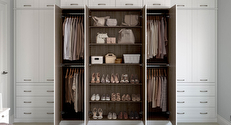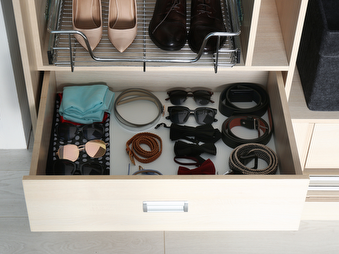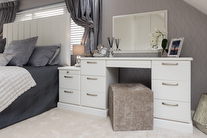
Fitted wardrobe door options: Sliding vs. hinged
When it comes to transforming your bedroom with fitted wardrobes, one of the most important decisions is choosing the right door style.

We understand just how important it is to keep on top of your wardrobe and the contents inside it.
In an era when fast-fashion and throw-away clothing are rife, we often feel pressure to keep up to date with the latest trends and invest in new clothes, accessories and footwear. But just how much value are you getting out of the spontaneous payday purchases you’ve accumulated in your wardrobe?
Here at Hammonds, we conducted a survey of 2,000 UK adults to identify the average value of the nation’s clothes, and those where we see the greatest ‘return on investment’ based on cost per wear. We’ve also explored how many of us are guilty of holding on to our wardrobe contents, even if there are items we’ve never worn taking up valuable space.
We also spoke to a fashion expert who shared their top tips on managing the contents of your wardrobe, alongside how to keep your everyday items looking in tip top condition whilst in storage.

Our survey found that out of all the clothing and accessories we own, our watches and sunglasses offer the best value for money, clocking in at just 6p per wear on average, meaning we see the best ‘return on investment’ from these fashion purchases.
Watches are proven to be a quality long-term investment – in fact, our research found out that almost a quarter (24%), equivalent to nearly 13 million UK adults, admitted they've only ever owned one watch.
In third place on our list was hats, which narrowly missed out on a joint top spot, averaging just 7p per wear.
In fourth place were trousers, which clocked in at only 14p per wear. When considering just how often professionals working from offices, schools, and other white-collar environments will wear them (and of course there are at-home and social occasional too), it seems a good pair of trousers offers great value for money and is an essential in any capsule collection.
Completing the top five were pyjamas, and with nearly four in ten (37%), or just under 20 million UK adults, admitting they wear them daily, it is clear to see why they make the top five at just 16p per wear.
The items of clothing / accessories we own that offer the best value for money (based on cost per wear) are:

Unsurprisingly, our research found that occasion wear such as formal suits and dresses were the two worst items when it came to cost per wear.
Formal suits were found to be the most expensive item in our wardrobe, costing a whopping £14 per wear on average. More than one in five (22%) said they wait more than five years to replace their formalwear outfits, as these aren’t worn very often.
In second place, dresses racked up an average cost of £7 per wear, but this could be even more in some wardrobes if you own several you’ve never actually put on!
In third, and worn substantially more often than dresses, were jeans. Although a pair of denims typically comes in at a respectable 75p per wear, 15% could get this cost down further as they will keep them for at least five years.
In fourth place on our list were trainers, which average 59p per wear. Some Brits will even go as far as replacing their pairs quite regularly, with one in ten (10%) or over 5 million UK adults revealing that they throw their trainers away monthly.
Outdoor boots completed our top five at 57p per wear, and whilst designed to last, the fact we don’t use these a lot means they can end up being quite a big expense.
The items of clothing / accessories we own that offer the worst value for money (based on cost per wear) are:

Across the UK, fashion, trends and lifestyles mean that our wardrobes are very varied.
For example, a third of 18–34-year-olds (33%) in the UK admit that they wear loungewear every day, which is in stark contrast to the older generation, with almost half of 65+ people in the UK (46%) revealing they don’t own a single item of loungewear.
With casual attire in particular there are some big differences between generations, as just under a third of boomers (31%) say they wear jeans every day, compared to just one in ten 25–34-year-olds (11%) who take a more ‘smart casual’ approach on a daily basis.
It could well be time to upgrade the content of our underwear drawers sooner rather than later too. as around three in ten Brits (30%) have admitted they wait more than five years before replacing their socks and underwear!
Perhaps owing to the great northern weather, residents from Liverpool own the largest collection of coats in the entire UK, with one in five (19%) residents claiming to own at least five different coats, and a further two in five (39%) saying they wear one every day.
The best dressed accolade lies with the residents of Belfast, as almost one in ten (9%) living in the Northern Ireland capital claim to wear a suit every single day. This is in stark contrast to residents in Norwich where almost half of the local population (45%) declared they don’t wear a formal suit at all.
Regardless of the varied fashion trends of the British population, our spacious range of wardrobes are available in a broad range of designs and styles, including sliding and fitted, all crafted to suit the nation’s differing tastes.

Our previous research highlighted just how many items of clothing we are keeping unworn in our wardrobes, with more than eight in ten (84%) Brits adamantly holding onto their garments that are no longer getting any use (or never have), which can lead to a large accumulation of items over time.
On average, we hold onto around £174 of unworn clothing, with items hidden away in the bottom of our drawers and wardrobes. This works out at around £9.32 billion worth of unworn clothing in Britain’s households.

Socks and underwear are the two most prevalent items we find in our drawers and wardrobes, with around 16 pairs of each per person.
Jewellery followed closely behind with 12 individual items owned by each adult in the UK, on average.
Jumpers and T-shirts completed the top five most common items in our wardrobes, with Brits owning eight of each item, on average, meaning there’s plenty of different styles and combinations to hand for the varying seasons – in fact, that’s 64 different jumper and T-shirt combinations alone!
In total, the average UK adult owns 83 items of clothing, ranging from hats to trainers.

There are several things that you can do to keep your clothes clean and smelling fresh, even when they’re tucked away at the back of wardrobes or at the bottom of drawers. Amy Smith, a fashion expert from Vendula London explains:
Wash and dry them - before storing clothes, ensure that they have been cleaned properly, as items such as perfume or deodorant can cause stains over time, and pests can be attracted to dirt.
Use dryer sheets - packing dryer sheets alongside clothing can help to keep them fresh and can give them a nice smell, even if you only use a single sheet.
Use deodorise containers - deodorising and cleaning containers before storing your clothes inside of them can help to prevent musty smells.
Use a dehumidifier in your bedroom or walk in wardrobe - dehumidifiers can help to prevent bad odours, remove humidity and will keep mould or mildew from growing on your clothes.
Do not use vacuum bags - although vacuum bags are a great thing that can help if you are low on space, they should not be used to store clothes long term. Items made from natural fibres such as wool and silk can be damaged and lose their shape over time if stored in plastic bags. If you intend to store clothes for more than a few months, a plastic box that can be sealed so it is airtight is the better option.
Store in the right location - you should generally store clothes somewhere that is dry, cool and dark, as items exposed to bright light may begin to fade and lose their colour.

Amy shared a few other top tips such as...
“Keeping a small jar (with small holes in the lid) of coffee beans or grounds with your clothes can help to neutralise odours, just as sachets of lavender can assist with repelling moths. The nitrogen that is present in coffee naturally neutralises odours, but it will need to be replaced once a month so it remains effective. Similarly, hanging eucalyptus sprigs can also repel insects, and the oil produced by the plant is antibacterial and antifungal.
“Some clothing can be folded when stored away, meaning that items are much easier to fit into smaller spaces compared to those that need hanging. Activewear is better folded, as the synthetic materials used to make the clothes can warp easily when hung up. Additionally, denim is one of the easiest items to store away as it holds its shape well when folded.
“Pleated items or clothing that wrinkles easily can be hard to keep looking fresh when stored. These items also often need to be hung up, and then do tend to take up a fair bit of space so keep that in mind."
Our research shows that watches are proven to be the best cost per wear item that we have sat in our wardrobes. If you are now thinking of upgrading your current wrist piece, we spoke with Jeremy Hinds, Sales Development Director at high-street jewellers F. Hinds, who shares everything you need to look out for including every day wear tips to keep your watch in tip top condition
“Watches make great long-term investments. Not only are they practical, but the wide variety of types and styles mean your options are limitless. Before purchasing, we recommend deciding what the main use for your watch will be.
“Fancy something fun for summer? We recommend picking something with a leather strap, as these come in different colours and styles. Have fun with it!
“If you’re after something practical and classic, opt for stainless steel. Not only is stainless steel resistant to corrosion and tarnishing, but it’s also comfortable yet stylish so a popular choice for many.
“If you’re looking for a nice accessory to dress up an outfit, go for something gold or embellished. Watches don’t have to be plain, something gold plated or featuring a crystal bezel will help dress up any plain evening attire.
“Often worn every day, there are a few things you need to know to keep a watch in tip top condition.
“For water resistant watches, you can simply wash in a bowel of semi-warm water and dish soap, with a soft, clean toothbrush to help brush away a build-up or dirt and oils. Be sure your toothbrush is nice and soft, to avoid causing any scratches.
“Many watches aren’t water resistant; however, these still need to be maintained to keep them looking box fresh. Non-water-resistant watches along with those with a leather strap should never be immersed in water. Instead, gently wipe with a moist cloth and leave to air dry fully before wearing.
“Something many do not know, is how magnetism can affect your watch. Magnetism from household products such as, headphones, loudspeakers, refrigerator door magnets or even blenders are strong enough to affect the performance of an analogue clock. It is because of this; we would recommend keeping your watch away from these things for long periods of time.”
Whilst a number of us are not wanting to part ways with our lesser worn outfits, even those that have not seen the light of day in some time, our expansive range of storage solutions offer an effective and sustainable resolution to your unworn clothing problems.
Our range of fitted wardrobes come in a wide variety of styles to help you keep on top of your clothing contents all year-round and store those garments you’re saving away for a rainy day.
Sources & Methodology
Using both desk research and a national UK survey of 2,000 we created a cost per wear figure on 18 of the most commonly used clothing items from Brits wardrobes.
We sourced the average cost price of popular clothing items. We then found out via the survey how many times people were wearing these items, revealing the order of most to least loved items. Via the survey, we also found out how many days per year the items are worn, how many of each item are owned, and how often these items have been replaced.
This then led us to the final sum of the cost per wear, per year for each item.

When it comes to transforming your bedroom with fitted wardrobes, one of the most important decisions is choosing the right door style.

Furnishing a small bedroom can often feel like a tricky balancing act between style and practicality.

An elegant dressing table can feel like an impossible luxury in a small bedroom.
Whether you have an exact vision in tow, or are just at the beginning stage of your home renovation, we have heaps of inspiration for you to get stuck into.
Find a wealth of design tips, trends and inspiration in the pages of our brochure, magazine and on our blog. Our experts are always ready to help you create dream home, pop in store or book your free design visit for experts to help on bringing your vision to life.